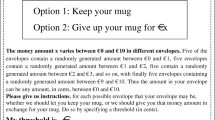Abstract
In this article, we show that behavioral features can be obtained at a group level even if they do not appear at the individual level. Starting from a standard model of Pareto optimal allocations, with expected utility maximizers but allowing for heterogeneity among individual beliefs, we show in particular that the representative agent has an inverse S-shaped probability distortion function as in Cumulative prospect theory.
Similar content being viewed by others
References
Abel A. (2002) An exploration of the effects of pessimism and doubt on asset returns. Journal of Economic Dynamics and Control 26: 1075–1092
Abdellaoui M. (2000) Parameter-free elicitation of utilities and probability weighting functions. Management Science 46: 1497–1512
Abdellaoui, M., L’Haridon, O. & Paraschiv, C. (2010). Individual vs collective behavior: An experimental investigation of risk and time preferences in couples, Working Paper.
Chateauneuf A., Cohen M. (1994) Risk seeking with diminishing marginal utility in a nonexpected utility model. Journal of Risk and Insurance 9: 77–91
Chiappori P-A. (1988) Nash-bargained households decisions: A comment. International Economic Review 29: 791–796
Chiappori P-A. (1992) Collective labor supply and welfare. Journal of Political Economy 100: 437–467
Chiappori, P.-A., Samphantharak, K., Schulhofer-Wohl, S. & Townsend, R. (2010). Heterogeneity and risk sharing in Thai villages, Working Paper.
Diecidue, E. & Wakker, P. (2001). On the intuition of rank dependent utility. Journal of Risk and Insurance, 281–298.
Gollier C. (1997) A note on portfolio dominance. Review of Economic Studies 64: 147–150
Gollier C., Zeckhauser R. (2005) Aggregation of heterogeneous time preferences. Journal of Political Economy 113(4): 878–898
Gonzalez R., Wu G. (1999) On the shape of the probability weighting function. Cognitive Psychology 38: 129–166
Jouini E., Napp C. (2007) Consensus consumer and intertemporal asset pricing with heterogeneous beliefs. Review of Economic Studies 74: 1149–1174
Jouini E., Napp C. (2008) On Abel’s concept of doubt and pessimism. Journal of Economic Dynamics and Control 32: 3682–3694
Landsberger M., Meilijson I. (1990) Demand for risky assets: A portfolio analysis. Journal of Economic Theory 50: 204–213
Landsberger M., Meilijson I. (1993) Mean preserving portfolio dominance. The Review of Economic Studies 60: 475–485
Lengwiler Y. (2005) Heterogeneous patience and the term structure of real interest rates. American Economic Review 95: 890–896
Loewenstein G., Prelec D. (1992) Anomalies in intertemporal choices: Evidence and an interpretation. The Quarterly Journal of Economics 107: 573–597
Lopes L. (1987) Between hope and fear: The psychology of risk. Advances in Experimental Social Psychology 20: 255–295
Luce R. D. (1996) When four distinct ways to measure utility are the same. Journal of Mathematical Psychology 40: 297–317
Mazzocco, M. & Saini, S. (2011) Testing efficient risk sharing with heterogeneous risk preferences. American Economic Review, (forthcoming).
Nocetti D., Jouini E., Napp C. (2008) Properties of the social discount rate in a Benthamite framework with heterogeneous degrees of impatience. Management Science 54: 1822–1826
Prelec D. (1998) The probability weighting function. Econometrica 66: 497–527
Reinschmidt K. F. (2002) Aggregate social discount rate derived from individual discount rates. Management Science 48: 307–312
Shefrin H. (2005) A behavioral approach to asset pricing. Elsevier.
Tversky A., Fox C. R. (1995) Ambiguity aversion and comparative ignorance. Quarterly Journal of Economics 110: 585–603
Tversky A., Kahneman D. (1992) Advances in prospect theory: Cumulative representation of uncertainty. Journal of Risk and Uncertainty 5: 297–323
Ulf, D. (1988). A general non cooperative Nash model of household consumption behavior, Working Paper 88–205, Department of Economics, University of Bristol.
Weitzman M. (1998) Why the far distant future should be discounted at its lowest possible rate. Journal of Environmental Economics and Management 36: 201–208
Weitzman M. (2001) Gamma discounting. The American Economic Review 91: 260–271
Wu G., Gonzalez R. (1996) Curvature of the probability weighting function. Management Science 42: 1676–1690
Wu G., Gonzalez R. (1998) Common consequence conditions in decision making under risk. Journal of Risk and Uncertainty 16: 115–139
Yaari M. E. (1987) The dual theory of choice under risk. Econometrica 55: 95–115
Author information
Authors and Affiliations
Corresponding author
Electronic Supplementary Material
The Below is the Electronic Supplementary Material.
Rights and permissions
About this article
Cite this article
Jouini, E., Napp, C. Behavioral biases and the representative agent. Theory Decis 73, 97–123 (2012). https://doi.org/10.1007/s11238-011-9274-3
Published:
Issue Date:
DOI: https://doi.org/10.1007/s11238-011-9274-3




